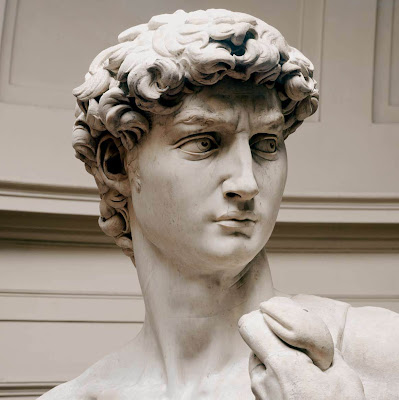Some have written that when you look into the eyes of David, you are
"looking into the eyes of Renaissance Man". All well and good, but the
only way you'll be able to do that is if you bring a twenty-foot ladder;
David is actually seventeen feet tall and stands atop a six-foot
pedestal.
Originally intended to adorn the roofline of the Duomo, the city
fathers later decided to place him - along with Hercules & Cacus - more
prominently at the entrance to the Palazzo Vecchio. Today he stands in
the Accademia museum in a Renaissance style dome designed just for
him...and the flocks of tourists ogling him!
Started in 1501 by a twenty-something Michelangelo, David was carved
from one solid (though to other artists, flawed) block of Carrara
marble and took three years to complete. This 'goliath-sized' statue is
arguably the quintessential statement of the power of man and was
immediately adopted by the citizenry as the symbol of Florence. Based on
the Bible story Davis vs. Goliath, this is obviously no timid
shepherd boy but a fully grown man, confident and armed only with a
sling and the god-given armor of his body. Art Historians write David is
the ultimate symbol of the divine victory of Humanism over the ignorant
and evil excesses of the Dark Ages.
Sitting at the foot of David, I did feel a kind of emotional energy
emanating out of the stone. It was hard to tell from his stance or his
expression just what he might have been thinking. Confidence? Anxiety? A
mixed bag of fight or flight? Perhaps only Michelangelo could have told
us, but from everything I've read about him that was unlikely. Regarded
by most at that time as the ugliest man alive, it's ironic that he
could create the epitome of human beauty in David.
David was a common and inspirational theme back in those days. There
are at least two other famous/controversial versions - one by Donatello
(1440) and the other by Verrocchio (1475). Both show David as a true
boy. Both show him with the head of Goliath at his feet. Donatello's
controversial version (naked with funny hat) was the first nude male
statue created since Roman times and stood in the Medici's private
garden where a 13-year-old Michelangelo had the chance to study it.
Verrocchio's was commissioned by Lorenzo da Medici (Lorenzo the
Magnificent) and popular legend has it that a young Leonardo da Vinci
was the model.
The lifelike and sometimes moody realism of all three of these
statues set the creative benchmark for many artists that followed.






No comments:
Post a Comment